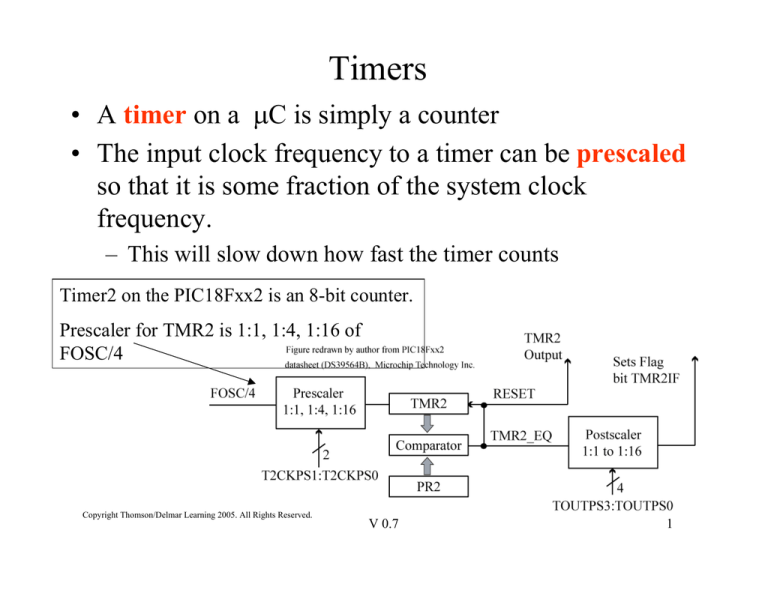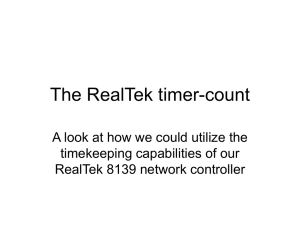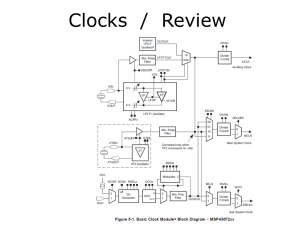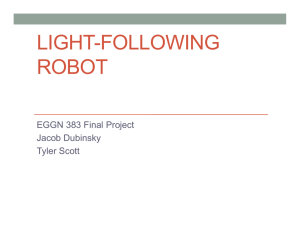
Timers
• A timer on a µC is simply a counter
• The input clock frequency to a timer can be prescaled
so that it is some fraction of the system clock
frequency.
– This will slow down how fast the timer counts
Timer2 on the PIC18Fxx2 is an 8-bit counter.
Prescaler for TMR2 is 1:1, 1:4, 1:16 of
FOSC/4
Copyright Thomson/Delmar Learning 2005. All Rights Reserved.
V 0.7
1
Period Register
• A timer can be programmed to roll over at any point using the
period register.
– An 8-bit timer would typically roll over to 0x00 once it
reached 0xFF.
– However, if the period register is set to 0x7F, then timer will
roll over to 0x00 once it increments past 0x7F.
PR2 is the
period register
for TMR2
V 0.7
2
Copyright Thomson/Delmar Learning 2005. All Rights Reserved.
Postscaler
• Would like to generate an interrupt when a timer
rolls over
• A Postscaler is used as a second counter – only
generate an interrupt after timer rolls over N
times.
Copyright Thomson/Delmar Learning 2005. All Rights Reserved.
V 0.7
Postscaler – all
values from 1:1
to 1:16. 3
PIC18Fxx2 Timer Summary
•
•
•
•
•
Timer0: software selectable as either 8-bit or 16-bit, has a prescaler,
clocked by FOSC/4 or external clock.
Timer1: 16-bit, has a prescaler, used with capture/compare module,
clocked by FOSC/4 or external clock (has dedicated oscillator circuit,
so can support a second external crystal).
Timer2: 8-bit, has prescaler/period register /postscaler, used with
pulse-width modulation module
Timer3: A duplicate of Timer 1, shares Timer1’s dedicated oscillator
circuit.
Capture/Compare module
– 16-bit capture register, 16-bit compare register
– Used with timer1 or timer3 to provide additional time
measurement capabilities
The remainder of these notes concentrate on capability associated
with Timer2
V 0.7
4
So....what good are timers?
• Switch Debouncing
• Waveform Generation
• Sampling an input signal with ADC at a fixed
frequency
• Pulse Width Measurement
• Pulse Width Modulation
• Many other uses
V 0.7
5
Computing the Timer2 Interrupt Interval
(Chap. 10.8, 10.9)
The equation:
Timer2 interrupt interval = PRE * (PR2+1) * POST * (1/(Fosc/4))
has 3 unknowns: PRE, POST, and PR2.
Use a spreadsheet to calculate. Assume we want a interrupt
frequency of 4 KHz,
Interrupt Period = 1/ 4 KHz = 1/ 4000 = 0.00025 = 250 us.
Pick PRE and POST values, and solve the equation for PR2:
PR2 = [ (Interrupt Period)/(4 * TOSC * PRE *POST)] - 1
V 0.7
6
Solutions for
Timer2
Interrupt
Frequency of 4
KHz (Period =
250 us)
If PR2 > 255,
then invalid
solution as PR2
is an 8-bit
register
Copyright Thomson/Delmar Learning 2005. All Rights Reserved.
V 0.7
7
Timer2 Configuration
Copyright Thomson/Delmar Learning 2005. All Rights Reserved.
V 0.7
8
Switch Debounce Using Timer2 (Chap.
10.9)
Use Timer2 periodic interrupt to allow switch to settle
Copyright Thomson/Delmar Learning 2005. All Rights Reserved.
V 0.7
9
ISR for Switch Debounce
Assume Timer2 configured for 6 ms interrupt period.
V 0.7
Copyright Thomson/Delmar Learning 2005. All Rights Reserved.
10
main() for Switch Debounce
Copyright Thomson/Delmar Learning 2005. All Rights Reserved.
V 0.7
11
Capture/Compare/PWM Module (Chap
13.7)
• Each CCP Module contains
• 16-bit Capture Register, 16-bit Compare Register
• PWM Master/Slave Duty Cycle Register
• Pulse Width Modulation (PWM) mode is used to produce
a square wave without processor intervention
• Uses timer2 resource, and Compare register
• Square wave on output pin 100% hardware generated,
no software intervention
• Can vary the duty cycle via the Timer2 PR2 register
The remainder of these nodes discuss PWM mode, waveform
generation using period interrupts. Capture/Compare is discussed
later.
V 0.7
12
Pulse Width Modulation
Pulse Width Modulation (PWM) is a common technique for
controlling average current to a device such as a motor.
PIC18
Uses a square wave
with fixed frequency,
varying duty cycle.
RBx
RBx
High Pulse
width (PWH)
For a fixed frequency, the brightness of the LED will vary
directly with duty cycle. The higher the duty cycle (the longer
the high pulse width), the brighter the LED because it stays on
longer (more current delivered to the LED)
V 0.7
13
PWM DAC
Can build a
low-component
count DAC by
using PWM to
control the
voltage across a
capacitor. The
capacitor
voltage varies
linearly with the
duty cycle.
Copyright Thomson/Delmar Learning 2005. All Rights Reserved.
V 0.7
14
PWM Motor Control
Copyright Thomson/Delmar Learning
2005. All Rights Reserved.
The voltage on the gate of the MOSFET varies linearly with the
duty cycle (the gate of the MOSFET looks like a capacitor). This
in turn varies the current through the MOSFT, controlling the
motor speed. The MOSFET is NOT
V 0.7 rapidly turning off/on.
15
PIC18Fxx2 PWM
Copyright Thomson/Delmar Learning 2005. All Rights Reserved.
V 0.7
16
PIC18Fxx2
PWM Period
Period = (PR2+1) * 4 * (1/Fosc) * TMR2_Prescale
Note that when TMR2 is used for PWM, the postscaler is NOT
used.
Copyright Thomson/Delmar Learning 2005. All Rights Reserved.
V 0.7
17
PIC18Fxx2 PWM Duty Cycle
Duty cycle has 10-bit
resolution, upper 8-bits in
CCPR1L, lower two bits
are CCP1CON<5:4>
CCPR1H used to double
buffer the PWM operation.
When TMR2=PR2, output
SET, TMR2 reset to 0.
When TMR2 = CCPR1H,
then output RESET
Copyright Thomson/Delmar Learning 2005. All Rights Reserved.
V 0.7
18
PIC18Fxx2 PWM Duty Cycle
Duty Cycle = CCPR1L:CCPCON<5:4> * (1/Fosc) * TMR2_prescale
10 bits.
Recap: Period defined by PR2, duty cycle by CCPR1L + 2 bits
The duty cycle time should be less than the period, but this is
NOT enforced in hardware.
If duty cycle > Period, then the output will always be a high (will
never be cleared).
In our calculations, will ignore lower 2-bits of duty cycle and only
use 8-bits that are in CCPR1L.
V 0.7
19
PWM Test: sqwave.c
Generate a square wave using TMR2 and the PWM capability.
// configure timer 2
// post scale of 1
PIC18Fxx2
TOUTPS3 = 0; TOUTPS2 = 0;
TOUTPS1 = 0; TOUTPS0 = 0;
// pre scale of 4
T2CKPS1 = 0;
T2CKPS0 = 1;
// start timer 2
TMR2ON = 1 ;
RC2/
CCP1
generate
square wave
with varying
duty cycle
using PWM
module
PR2 = 255; // set timer2 PR register
CCPR1L = (255 >> 1); // 255/2 = 50% duty cycle
bitclr(CCP1CON, 5); // lower two bits are 00
bitclr(CCP1CON, 4);
V 0.7
20
sqwave.c (cont)
// set CCP1 output
TRISC2 = 0;
Pin RC2 must be configured as
output.
// PWM Mode
bitset(CCP1CON, 3);
bitset(CCP1CON, 2);
Configures
Capture/Compare/PWM
module for PWM operation
while(1) {
// prompt user PR2, Prescale
// values, code not shown.
}
At this point, the square
wave is active, no other
intervention necessary.
}
V 0.7
21
PWM test: ledpwm.c
Use potentiometer and PIC18Fxx2 ADC to adjust duty cycle
for PWM to LED
Analog
input
Vdd
PIC18Fxx2
AN0
RC2/
CCP1
10K Pot.
Use this adjust duty cycle
Will initialize PWM module in the same way as before,
except TMR2 interrupt will be enabled. In ISR, read ADC
value and update duty cycle.
V 0.7
22
ledpwm.c (cont)
void interrupt timer2_isr(void)
{
update_pwm();
TMR2IF = 0; //clear timer2 interrupt flag
}
This subroutine does work of reading A/D
and changing the duty cycle.
V 0.7
23
ledpwm.c (cont)
update_pwm(){
unsigned char rval1;
rval1 = ADRESH; // A/D value left justified
CCPR1L = rval1; // upper 8 bits of duty cycle
rval1 = ADRESL;
// update lower two bits of duty cycle
if (bittst(rval1,7))
bitset(CCP1CON, 5);
else bitclr(CCP1CON, 5);
if (bittst(rval1,6)) bitset(CCP1CON, 4);
else bitclr(CCP1CON, 4);
// start new conversion
GODONE = 1; // start conversion
}
V 0.7
24
Waveform Generation using Periodic
Interrupts: sinegen.c
Analog
input
Vdd
Vdd
PIC18Fxx2
Sinewave
Maxim 517
OUT1
AD1
RA0/AN0
10K Pot.
OUT0
RC3/SCK/SCL
SCL
RC4/SDI/SDA
SDA
AD0
Potentiometer used to vary the PR2 timer value between a
min value of 25 and max value of 100. This varies TMR2
interrupt time. Sinewave is produce by table look-up (either
16-entry table or 64-entry table). Period of Sinewave is
number_table_entries * tmr2_interrupt_interval.
V 0.7
25
16 Entry Table
const unsigned char sine16tab[] =
{0x80,0xb0,0xda,0xf6,0xff,0xf6,0xda,0xb0,0x80,0x4f,
0x25,0x9,0x0,0x9,0x25,0x4f};
300
250
246
255
246
218
218
200
176
176
150
128
128
100
79
50
79
37
37
9
0
0
1
2
3
4
5
6
7
8
V 0.7
9
10
11
9
0
12
13
14
15
26
Period
TMR2 interrupt interval. New entry read
from table each interrupt.
Period = 16 * TMR2 interrupt interval.
300
250
246
255
246
218
218
200
176
176
150
128
128
100
79
50
79
37
37
9
0
0
1
2
3
4
5
6
7
8
9
V 0.7
10
11
9
0
12
13
14
15
27
Saving Data Space
• 64-entry table is same as 16-entry, just finer grain
– Both end up being stored in File Register memory
(Bank1)
• Could save File Register memory by noting that
really only have to save ¼ of the waveform
1st
2nd
3rd
2nd quarter is 1st quarter
read in reverse order.
4th
3rd quarter = 1st – 0x80
0x80
4th quarter = 1st – 0x80
read in reverse order
V 0.7
28
sinegen.c (main loop)
while(1) {
if(dac_flag) {
if (tabmax == 16)
dac_flag set by ISR
tabmax chooses between 16entry, 64-entry tables.
update_dac(sine16tab[sineptr]);
else
update_dac(sine64tab[sineptr]);
dac_flag = 0;
Read value out of
table, update DAC.
if (pr_flag) {
update_period();
pr_flag = 0;
pr_flag set by ISR when at
end of period (16 or 64)
}
}
}
Read ADC to get new TMR2 interval, update PR2
V 0.7
29
sinegen.c (ISR)
void interrupt timer2_isr(void)
{
Move to next entry in table
sineptr++;
if (sineptr == tabmax){
sineptr = 0;
pr_flag = 1;
}
Reset if at end of table
Signal to main loop that
end of period reached, need
to update period
dac_flag = 1;
TMR2IF = 0; clear timer interrupt flag
Signal to main loop that
interrupt occurred.
}
Clear TMR2 interrupt flag so interrupt can
happen again.
V 0.7
30
sinegen.c (update_period)
update_period(){
Read A/D, get upper 7 bits,
clip to between MIN/MAX
to limit range of interrupt
period. ADC configured for
left justification.
// read ADC result,
// use as period, start new conversion
rval = ADRESH >> 1; // only keep upper 7 bits
if (rval < MIN_PERIOD) rval = MIN_PERIOD;
if (rval > MAX_PERIOD) rval = MAX_PERIOD;
PR2 = rval;
// set timer2 period register
// start new conversion
GODONE = 1;
Set new PR2 value, start
new conversion.
}
V 0.7
31
Experiment 11 Task: Waveform Generation
Generate a waveform that consists of 1 or more sine wave cycles,
1 or more triangle wave cycles, 1 or more square wave cycles.
A 1x period is defined as 64 * TMR2 interrupt interval – sine
wave will ALWAYS have a 1x period (use 64 table lookup).
Square wave and Triangle waves can have a period of 0.5X (32
intervals), 1.0X (64 intervals) or 2.0X (128 intervals).
Square wave/Triangle wave can also be inverted.
V 0.7
32
1x
64 tmr2
interv.
1x
64 tmr2
interv.
1x
1x
Waveform
Examples
64 tmr2
interv.
64 tmr2
interv.
1x,
inverted
1x,
inverted
64 tmr2
interv.
64 tmr2
interv.
V 0.7
33
1x
64 tmr2
interv.
2x
128 tmr2 interv.
0.5x
Waveform
Examples
32 tmr2
interv.
Your assigned waveform is fixed in terms of type of component
waveforms, and inversion.
To generate square wave/triangle wave – can use table lookup if
desired as long as tables are stored in Program Memory using the
‘const’ modifier. As an alternative, square wave and triangle
wave values are easy to ‘compute’ based on current value and
V 0.7
34
sample number.
Triangle Wave Computation
Non-inverted
1st
2nd
3rd
In 1st, 3rd sections: new_value = old_value + delta
In 2nd section:
new_value = old_value - delta
Delta depends on number of points (period) of waveform.
Be careful of wrap-around at low/high points (0x00, 0xFF).
V 0.7
35





